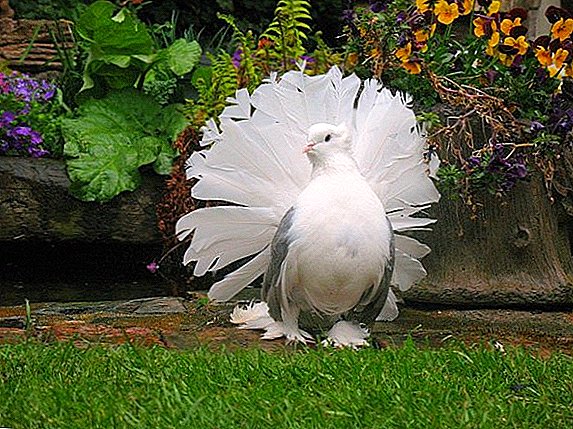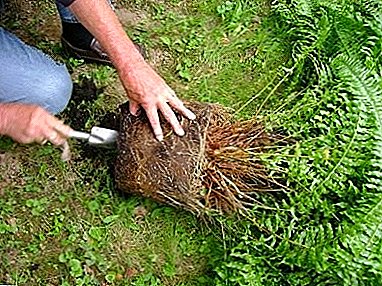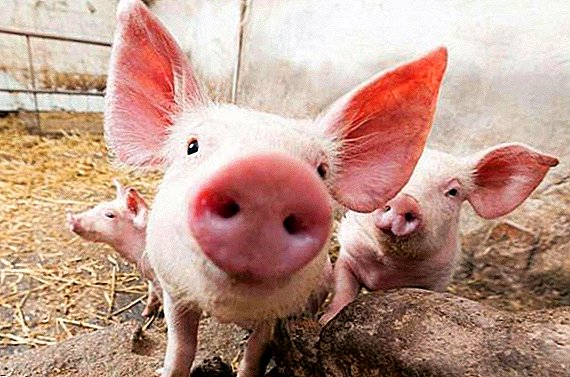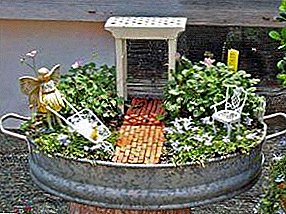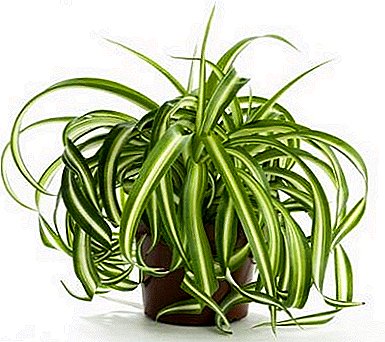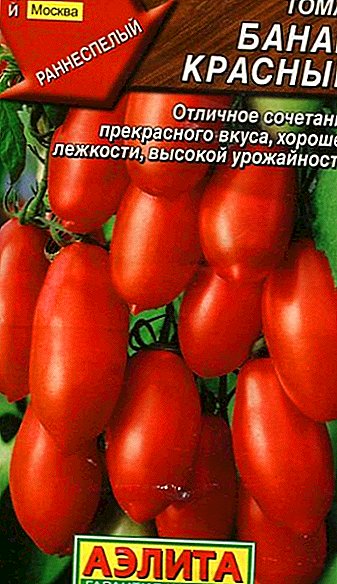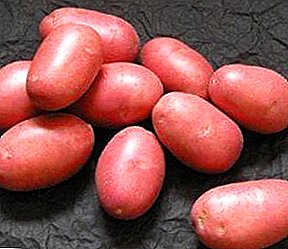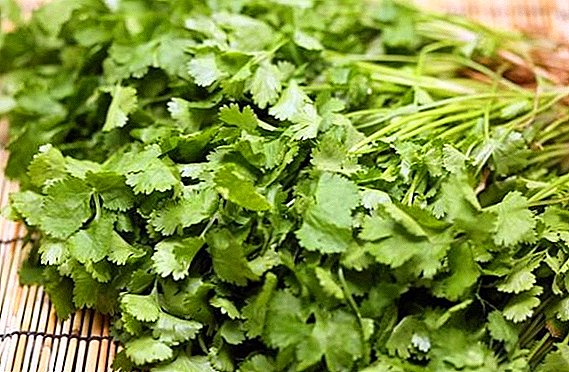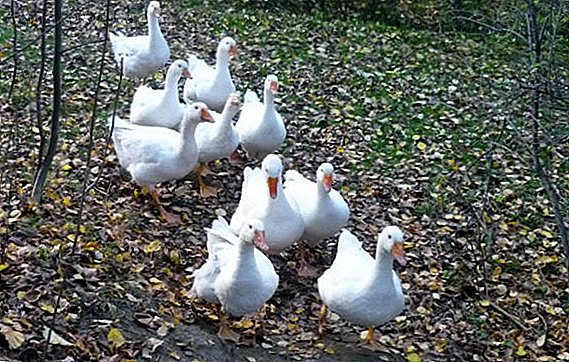 “The situation is worse than the governor’s” is not an expression of the gubernatorial geese, the breed of which, despite its youth, actively obtains a permanent residence permit in poultry farms and in rural farmsteads. Snow-white beauties with magnificent down, meat of refined taste and dietetic eggs - the geese of the governor's breed today cause considerable interest from professional poultry breeders and home breeders.
“The situation is worse than the governor’s” is not an expression of the gubernatorial geese, the breed of which, despite its youth, actively obtains a permanent residence permit in poultry farms and in rural farmsteads. Snow-white beauties with magnificent down, meat of refined taste and dietetic eggs - the geese of the governor's breed today cause considerable interest from professional poultry breeders and home breeders.
Origin
 At the beginning of the XXI century, Russian breeders set themselves the task of breeding goose, which would be characterized by increased viability combined with high productivity.
At the beginning of the XXI century, Russian breeders set themselves the task of breeding goose, which would be characterized by increased viability combined with high productivity.
For eleven years, carrying out the difficult work of crossing birds of the local shadrinskoy and italian rocks, poultry farmers sought from all new goose generations of the desired qualities and as a result received an excellent result. Today, the gubernatorial breed, despite its more than modest experience, is no longer just on hearing, but also in the roost of many poultry farmers.
Did you know? Geese belong to the elders in the poultry family. The first geese were tamed in ancient Egypt over four thousand years ago.
Description and Features
These birds are not only remarkable for their consumer qualities, but also truly beautiful.
Exterior
If you look at the goose and the geese of the governor’s breed more closely, you can see that they have:
- plumage color - radically white;
- tail - small;
- head - oblong. It lacks a lump traditional for geese on the forehead;
- chest - strong and wide, not much protruding;
- wings pressed to the body and sufficiently developed;
- beak - short, orange;
- neck - medium length and thickness;
- back - straight and wide;
- metatarsus orange color;
- plumage - dense with plenty of fluff;
- trunk - proportional, compact.

Character
The birds of the governor's breed are pretty loving, although at danger they can stand up for themselves and for their relatives. A feature of the goose of this breed is their polygamous. That is, they do not demonstrate the swan fidelity inherent in many other goose breeds, but are ready to give their love to several geese at once.
Check out the tips for growing geese and goslings.
Laying period and average annual egg production
The laying period of a goose lasts four and a half months, during which it lays an average of 46 eggs. The average annual egg production is about 100 eggs.
The rate of precocity, live weight goose and goose
The birds of this breed are distinguished by early maturity, already at two months of age they almost reach the weight categories of adults, which are 4.5 kg for gander and 4 kg for goose.  At the same time, it is worth noting that the marble meat of these birds is distinguished by very high palatability.
At the same time, it is worth noting that the marble meat of these birds is distinguished by very high palatability.
Learn more about the composition, beneficial properties and culinary use of goose meat, fat, eggs.
Conditions of detention
Bringing this breed, breeders one of the main qualities peculiar to her, suggested increased vitality. The result was a hardy bird, distinguished by unpretentiousness and cold resistance. However, it also needs to create conditions for the most comfortable keeping, on which the productivity of the bird directly depends.
Requirements for the room
Floaters for overnight stay and upkeep in winter are located in specialized goose or in the shed that replaces it. The size of the room is easily determined based on the fact that each individual requires at least 1 square meter of living space.  It is not necessary to heat the goose, it is sufficiently well insulated so that in winter the temperature does not fall below 5 degrees Celsius. But lower temperatures are not terrible for birds, although they, of course, are less comfortable for them.
It is not necessary to heat the goose, it is sufficiently well insulated so that in winter the temperature does not fall below 5 degrees Celsius. But lower temperatures are not terrible for birds, although they, of course, are less comfortable for them.
The main requirements for the room where the waterfowl are kept are: no drafts and thick bedding of hay, straw, sawdust, shavings or sunflower husks on the floor in order to avoid moisture - the main enemy of geese, even though they are waterfowl.
Important! The litter in the goose should be changed as often as possible, making sure that in no case is it wet.
For the same reason, the floor of the room itself must often be raised above the ground or concreted to protect against moist soil in lowlands or from close-lying groundwater where this is the case. In addition, you should take care of ventilation, which is done only on one side of the room, in order to avoid drafts.  It is recommended to install in the goose artificial lightingable to provide birds with a day length of 14 hours. It stimulates the production of eggs by geese.
It is recommended to install in the goose artificial lightingable to provide birds with a day length of 14 hours. It stimulates the production of eggs by geese.
Did you know? Not only webbed feet and waterproof feathers rank geese as waterfowl. Goslings of age just one day swim no worse than mom.
Pasture for walking
Goose is a dynamic bird. It requires a lot of movement, and stagnation is extremely harmful. Therefore, the maximum possible amount of time geese should spend in the fresh air. To do this, use the enclosures and pastures with access to the reservoir, which, however, is a desirable, but not mandatory condition.
The best pasture for this bird is the meadow with motley grass of small height.  Especially useful if there grow:
Especially useful if there grow:
- dandelion;
- clover;
- yarrow;
- sorrel;
- nettle;
- all kinds of legumes;
- alfalfa.
Since these waterfowl prefer fresh greens, it is advisable from time to time to mow the grass. A very successful pasture is obtained on the land where it was previously grown. cereals. Fallen in the ground and germinated seeds give sprouts that are extremely popular with members of this breed and are very useful for them.
Important! Extremely unloved geese sedge, goose foot and cuff can not only spoil their appetite, but also inspire fear in the birds at all to pinch some grass.
Access to water
For waterfowl, water is desirable and appealing. Therefore, in reservoirs for them arrange artificial reservoirs, and pastures are chosen closer to the river, lake or pond. In addition to the instinctive pleasure of swimming in the water, geese in natural waters also receive a rich and useful increase in their diet.  However, with regard to the obligatory presence of a water body in the places of grazing, experts have long ago arrived at an unequivocal conclusion that its presence or absence does not in any way affect the productivity of the bird.
However, with regard to the obligatory presence of a water body in the places of grazing, experts have long ago arrived at an unequivocal conclusion that its presence or absence does not in any way affect the productivity of the bird.
Familiarize yourself with the technology of building a pond at the site.
Feeders, drinkers and a trough with sand
The main property required from the feeder is ensuring all birds access to feed at the same time. The space required during feeding of each individual is about 30 cm. From this it is necessary and to go when installing feeders. For ease of use, feeders are often raised above the floor surface by about 20 cm.
Since an adult representative of the governor's breed drinks about one liter of water daily on average, it is clear that the water in the drinkers, even factory-made, even home-made, should always be present, and fresh, replaced at least three times a day.
The danger is created by the inevitable splashing of water from the drinkers, which leads to wetting of the litter and the formation of extremely undesirable high humidity in the room. To avoid this, wide trays are placed under the drinkers, into which the splashed water is collected. In winter, the water in the drinker can freeze, so the tank is either warmed or constantly poured hot water into it.  An indispensable addition to the feeders and drinkers in geese is container that fills:
An indispensable addition to the feeders and drinkers in geese is container that fills:
- large river sand;
- fine gravel;
- chalk;
- seashells;
- crushed eggshell.
These supplements are necessary to improve goose digestion - they help the bird grind food in the stomach. In addition, they supply the minerals it needs to the avian organism.
Feeding ration
Since geese spend most of their lives in the fresh air, extracting their own pasture on their own, which most successfully occurs in the warm season, the summer and winter rations differ considerably.
Learn how to feed geese and goslings at home.
In the summer
In summer, food in the form of meadow grass, and sometimes water plants, provides the bird with calories, vitamins, amino acids, and other nutrients contained in plants. However, this does not mean that geese are not fed in the summer.  In the evenings, waterfowers returning from pasture are offered succulent and coarse feed presented:
In the evenings, waterfowers returning from pasture are offered succulent and coarse feed presented:
- any grain;
- corn;
- chaff;
- beetroot
- potatoes;
- carrots.
And, of course, do not forget about mineral supplements.
Did you know? In addition to cock fighting, goose fights existed, but they were banned as early as the Russian Empire. In our time, in some places this "fun" is still occasionally found in some areas of the Russian Federation.
In winter
In winter, the entry of proteins into the goose's organism becomes more relevant, the deficiency of which is compensated mainly by grain. During the cold period, the bird is fed twice a day, applying daily menu consisting of:
- potatoes and beets in the amount of 0.5 kg;
- carrots - 0.1 kg;
- grains of any kind - 0.1 kg;
- hay flour - 0.15 kg;
- mineral supplements - 0.025 kg.

Advantages and disadvantages
Gubernatorial geese possess undoubted meritswhich are characterized by:
- high egg production and meat productivity;
- unpretentiousness and resistance to diseases;
- high fertility due to polygamous males;
- excellent survival rate of goslings, which is 95%, and adult birds, approaching 100%;
- the rapid growth of young animals;
- the ability to distinguish between sex goslings already at day old.
Read also about the breeds of geese for home breeding: Chinese, Toulouse, Kholmogory, Lind, Arzamas, Danish legart, Hungarian white, Rhine, Gorky, Tula.
Disadvantages this breed has not yet been found. True, some poultry farmers complain of some of the cost of growing these geese, in which it is necessary to expend three kilograms of feed to increase one kilogram of bird. However, as a result, due to the high cost in the market of marble meat of geese of this breed and of very valuable fluff, all costs for the maintenance of geese of this breed quickly pay off.
Video: gubernatorial geese
Reviews on the breed of gubernatorial geese

In record time, in just six years, the provincial breed of geese has managed not only to loudly declare itself, but has also successfully taken root in many poultry farms, in summer cottages and rural farmsteads. These snow-white imposing birds brought people both material dividends and purely aesthetic satisfaction from communicating with such wonderful representatives of nature.


